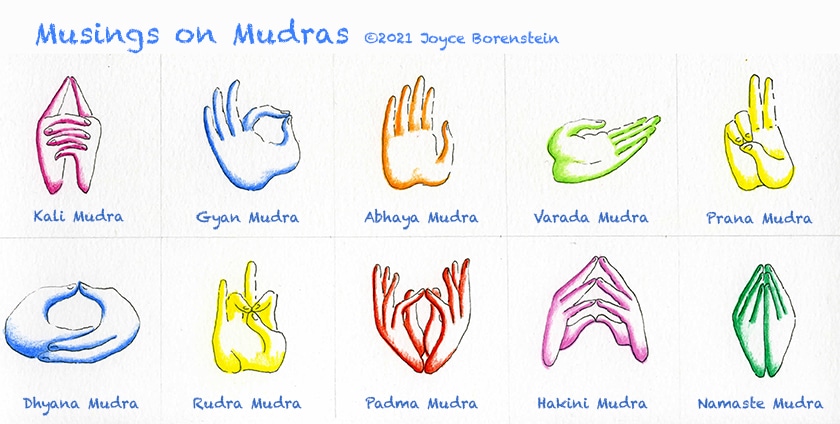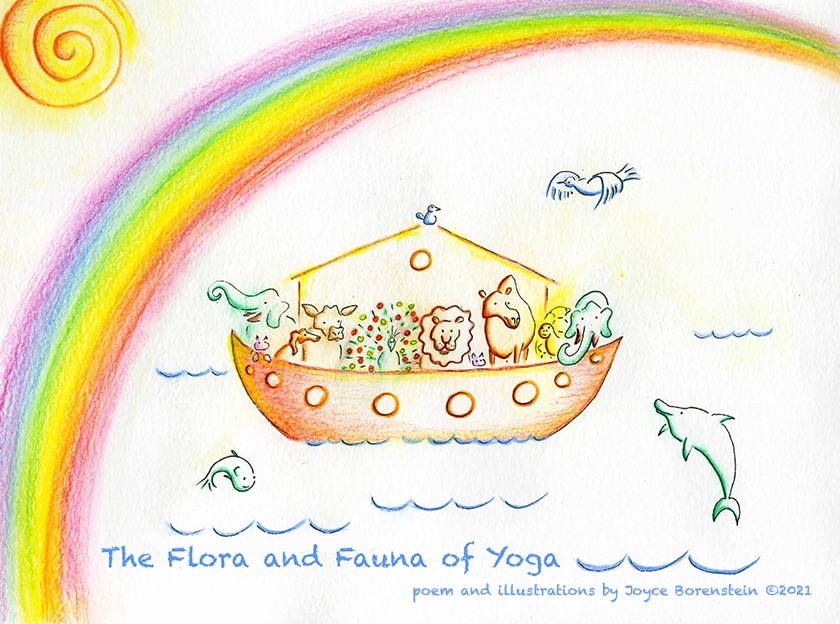text and illustration ©2021 Joyce Borenstein
research references Wikipedia
Hasta Mudras, (Sanskrit for Hand Gestures) are hand positions held during Meditation, during Yoga and Indian classical dance. There are over one hundred of them and each represents a positive behaviour or attitude. In Yoga, when assuming the hand position, the practitioner is meant to concentrate on the quality that the mudra represents, thereby building his neural networks for this quality, a kind of rehearsal for positive thoughts leading to positive actions. I love that there is so much meaning in each hand pose and that the meaning is conveyed in a universal way (silent without language). Mudras are elegant, poetic, mysterious, streamlined and profound!
Following is a list of some of the popular Mudras with explanations, all representing qualities to aspire to and to cultivate.

Kali Mudra (Kal is Sanskrit for the black one beyond time): this mudra represents fearlessness and courage and it is my favourite mudra. Kali was the supreme Hindu Goddess who protected the innocent and vanquished evil forces. She bestowed liberation. She is pictured as blue- or black-skinned with three red eyes (signifying past present and future), with dishevelled hair, with sometimes up to 10 arms. Serpents accompanied her. She is shown standing on her husband, the Hindu god Shiva, who lies calmly beneath her (an early feminist?).
Gyan Mudra (Sanskrit for wisdom): this mudra symbolizes focus and concentration, the evolution from ignorance into wisdom, darkness into light.
Abhaya Mudra (Sanskrit for fearlessness): this mudra is for developing courage and peace. When Buddha is pictured using both hands in this position, it symbolizes him “calming the oceans”.
Varada Mudra (Sanskrit for forgiveness): this mudra engenders generosity and compassion, and is often combined with the Abhaya Mudra for the right hand while the left hand is held in Varada Mudra. Imagine fearlessness, generosity and compassion all in one: great aspirations!
Prana Mudra (Sanskrit for life force energy): this mudra is for increased energy, clearing the blockages in the energy pathways, an energy pick-me-up.
Dhyana Mudra (Sanskrit for meditation): this mudra represents composure and balances the two sides of the brain for equanimity. The joining of the two thumbs symbolizes the union of the yin female and the yang male.
Rudra Mudra (Sanskrit for howler or terror): is for healing and energizing, this mudra promotes empowerment.
Padma Mudra (Sanskrit for lotus): symbolizing loving kindness, this mudra represents a full-blossoming lotus flower.
Hakini Mudra (Sanskrit for power): the mudra for control of one’s mind, for imagination and intuition, named after the Goddess Hakini who personified the energy of the third-eye chakra.
Namaste Mudra (Sanskrit for ‘I bow to you’): the mudra for peace, promoting one soul honouring another and recognizing our inter-connectedness.


